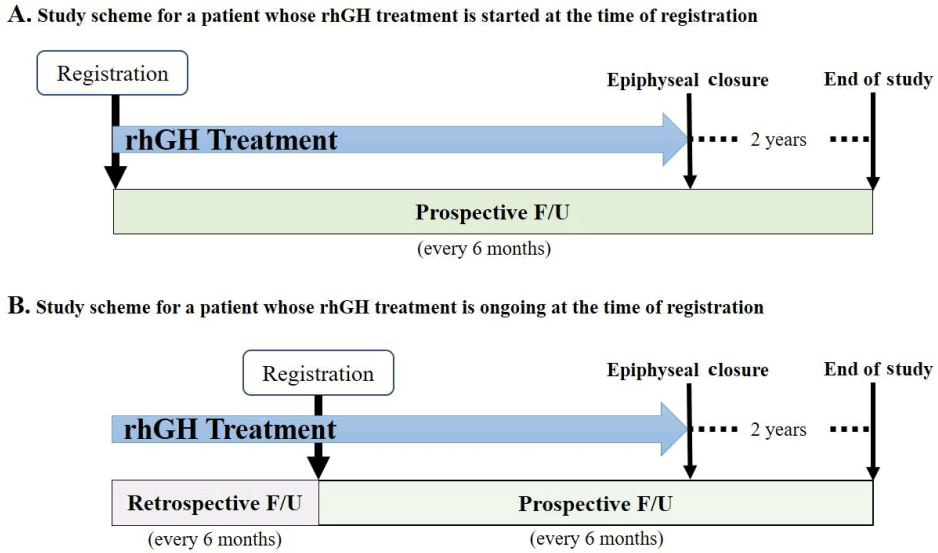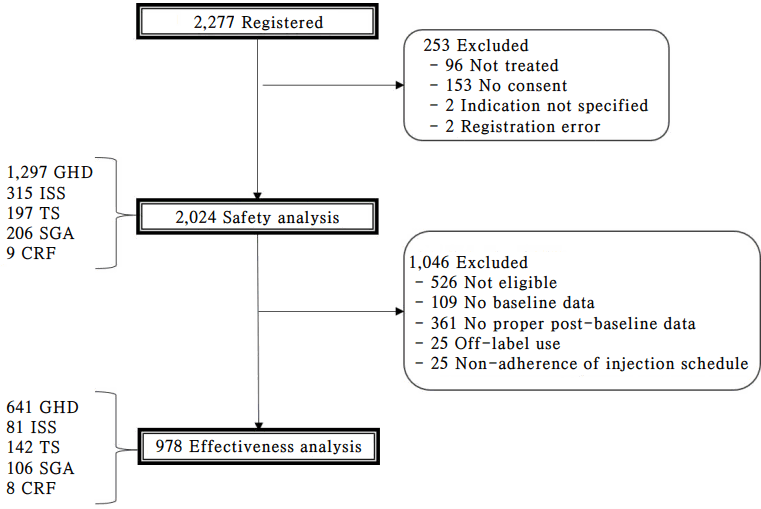1. Romero CJ, Dauber AN, Cohen LE. Childhood growth hormone deficiency and hypopituitarism. In : Radovick S, MacGillivray MH, editors. Pediatric endocrinology: a practical clinical guide. 2nd ed. New York: Humana Press;2013. p. 3–28.
2. Brown P, Brandel JP, Sato T, Nakamura Y, MacKenzie J, Will RG, et al. Iatrogenic Creutzfeldt-Jakob disease, final assessment. Emerg Infect Dis. 2012; 18:901–7.

3. Navarro R, Dunn JD, Lee PA, Owens GM, Rapaport R. Translating clinical guidelines into practice: the effective and appropriate use of human growth hormone. Am J Manag Care. 2013; 19(15 Suppl):s281–9.
4. Franklin SL, Geffner ME. Growth hormone: the expansion of available products and indications. Pediatr Clin North Am. 2011; 58:1141–65, x.

5. Kemp SF, Frindik JP. Emerging options in growth hormone therapy: an update. Drug Des Devel Ther. 2011; 5:411–9.

6. Allen DB, Backeljauw P, Bidlingmaier M, Biller BM, Boguszewski M, Burman P, et al. GH safety workshop position paper: a critical appraisal of recombinant human GH therapy in children and adults. Eur J Endocrinol. 2016; 174:P1–9.

7. Romer T, Saenger P, Peter F, Walczak M, Le Bouc Y, Khan-Boluki J, et al. Seven years of safety and efficacy of the recombinant human growth hormone Omnitrope in the treatment of growth hormone deficient children: results of a phase III study. Horm Res. 2009; 72:359–69.

8. Deodati A, Cianfarani S. Impact of growth hormone therapy on adult height of children with idiopathic short stature: systematic review. BMJ. 2011; 342:c7157.

9. Stephure DK; Canadian Growth Hormone Advisory Committee. Impact of growth hormone supplementation on adult height in Turner syndrome: results of the Canadian randomized controlled trial. J Clin Endocrinol Metab. 2005; 90:3360–6.

10. Kim SJ, Kim CW. Development and characterization of sodium hyaluronate microparticle-based sustained release formulation of recombinant human growth hormone prepared by Spray-Drying. J Pharm Sci. 2016; 105:613–22.

11. Péter F, Bidlingmaier M, Savoy C, Ji HJ, Saenger PH. Three-year efficacy and safety of LB03002, a once-weekly sustained-release growth hormone (GH) preparation, in prepubertal children with GH deficiency (GHD). J Clin Endocrinol Metab. 2012; 97:400–7.

12. Hwang JS, Lee HS, Chung WY, Han HS, Jin DK, Kim HS, et al. Efficacy and safety of LB03002, a once-weekly sustained-release human GH for 12-month treatment in Korean children with GH deficiency. Eur J Endocrinol. 2013; 169:179–85.

13. Khadilkar V, Radjuk KA, Bolshova E, Khadgawat R, El Kholy M, Desai M, et al. 24-month use of once-weekly GH, LB03002, in prepubertal children with GH deficiency. J Clin Endocrinol Metab. 2014; 99:126–32.

14. Lee KH, Lee BC, Ko CW, Jin DK, Yang SW, Yoo HW, et al. A single-arm, phase III study to assess efficacy and safety after 6-month-treatment of EutropinTM Inj. (recombinant human growth hormone) in prepubertal children with short stature due to small for gestational age. J Korean Soc Pediatr Endocrinol. 2011; 16:157–64.

15. Kim DH, Lee BC, Yang SY, Chung YY. Clinical effects of eutropin (recombinant human growth hormone) in patients with turner syndrome. J Korean Soc Pediatr Endocrinol. 1998; 3:172–83.
16. Kim HS, Yang SW, Yoo HW, Suh BK, Ko CW, Chung WY, et al. Efficacy of short-term growth hormone treatment in prepubertal children with idiopathic short stature. Yonsei Med J. 2014; 55:53–60.

17. Korea Centers for Disease Control and Prevention; Division of Chronic Disease Surveillance; Committee for the Development of Growth Standard for Korean Children and Adolescents; Korean Pediatric Society; Committee for School Health and Public Health Statistics. 2007 Korean children and adolescents growth standard (commentary for the development of 2007 growth chart). Cheongju: Korea Centers for Disease Control and Prevention, Division of Chronic Disease Surveillance;2007.
18. Hyun SE, Lee BC, Suh BK, Chung SC, Ko CW, Kim HS, et al. Reference values for serum levels of insulin-like growth factor-I and insulin-like growth factor binding protein-3 in Korean children and adolescents. Clin Biochem. 2012; 45:16–21.

19. Bell J, Parker KL, Swinford RD, Hoffman AR, Maneatis T, Lippe B. Long-term safety of recombinant human growth hormone in children. J Clin Endocrinol Metab. 2010; 95:167–77.

20. Kim JH, Hwang IT, Chung S, Rhie YJ, Chae HW, Choong HS. Long-term safety and effectiveness of daily and weekly GH treatment in pediatric patients. In : 54th Annual Conference of the European Society for Paediatric Endocrinology; 2015 Oct 1-3; Barecelona, Spain. Barcelona: The European Society for Paediatric Endocrinology. 2015. LBP-1270.
21. Chung S, Hwang IT, Rhie YJ, Kim JH, Chae HW, Choi JH, et al. Long-term safety and effectiveness of daily and weekly growth hormone treatment in pediatric GHD patients (4-years' results). In : 54th Annual Conference of the European Society for Paediatric Endocrinology; 2016 Sep 10-12; Paris, France. Paris: The European Society for Paediatric Endocrinology. 2016. RFC15.7.
22. Chung S, Hwang IT, Rhie YJ, Kim JH, Chae HW, Choi JH, et al. Long-term safety and effectiveness of growth hormone treatment in pediatric patients with growth hormone deficiency: interim results of LG growth study. In : 55th Annual conference of the European Society for Paediatric Endocrinology; 2016 Sep 10-12; Paris, France. Paris: The European Society for Paediatric Endocrinology. 2016. LBP11.
23. Lim JS, Lim SW, Ahn JH, Song BS, Shim KS, Hwang IT. New Korean reference for birth weight by gestational age and sex: data from the Korean Statistical Information Service (2008-2012). Ann Pediatr Endocrinol Metab. 2014; 19:146–53.

24. The periodic health examination. Canadian Task Force on the Periodic Health Examination. Can Med Assoc J. 1979; 121:1193–254.
25. Schulz KF, Altman DG, Moher D; CONSORT Group. CONSORT 2010 statement: updated guidelines for reporting parallel group randomized trials. Ann Intern Med. 2010; 152:726–32.

26. Blankenstein O, Snajderova M, Blair J, Pournara E, Pedersen BT, Petit IO. Real-life GH dosing patterns in children with GHD, TS or born SGA: a report from the NordiNet® International Outcome Study. Eur J Endocrinol. 2017; 177:145–55.
27. Höybye C, Sävendahl L, Christesen HT, Lee P, Pedersen BT, Schlumpf M, et al. The NordiNet® International Outcome Study and NovoNet® ANSWER Program®: rationale, design, and methodology of two international pharmacoepidemiological registry-based studies monitoring long-term clinical and safety outcomes of growth hormone therapy (Norditropin®). Clin Epidemiol. 2013; 5:119–27.
28. Swerdlow AJ, Cooke R, Albertsson-Wikland K, Borgström B, Butler G, Cianfarani S, et al. Description of the SAGhE Cohort: A Large European Study of Mortality and Cancer Incidence Risks after Childhood Treatment with Recombinant Growth Hormone. Horm Res Paediatr. 2015; 84:172–83.

29. Pfäffle R, Schwab KO, Marginean O, Walczak M, Szalecki M, Schuck E, et al. Design of, and first data from, PATRO Children, a multicentre, noninterventional study of the long-term efficacy and safety of Omnitrope(
®) in children requiring growth hormone treatment. Ther Adv Endocrinol Metab. 2013; 4:3–11.

32. ClinicalTrials.gov. National Cooperative Growth Study (NCGS) of optimal nutropin AQ and nutropin dosing in pubertal growth hormone-deficient (GHD) patients [Internet]. Bethesda (MD): U.S. National Library of Medicine;[cited 2017 May 31]. Available from:
https://clinicaltrials.gov/ct2/show/NCT00097513.
33. Lanes R. Long-term outcome of growth hormone therapy in children and adolescents. Treat Endocrinol. 2004; 3:53–66.

34. Desrosiers P, O'Brien F, Blethen S. Patient outcomes in the GHMonitor: the effect of delivery device on compliance and growth. Pediatr Endocrinol Rev. 2005; 2 Suppl 3:327–31.
35. Kapoor RR, Burke SA, Sparrow SE, Hughes IA, Dunger DB, Ong KK, et al. Monitoring of concordance in growth hormone therapy. Arch Dis Child. 2008; 93:147–8.

36. Cutfield WS, Derraik JG, Gunn AJ, Reid K, Delany T, Robinson E, et al. Non-compliance with growth hormone treatment in children is common and impairs linear growth. PLoS One. 2011; 6:e16223.







 PDF
PDF Citation
Citation Print
Print



 XML Download
XML Download